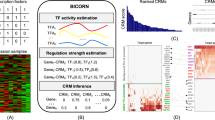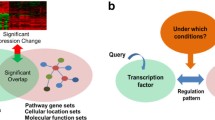Abstract.
Combinatorial regulation is a powerful mechanism for generating specificity in gene expression, and it is thought to play a pivotal role in the formation of the complex gene regulatory networks found in higher eukaryotes. The term ``Composite Element'' (CE) refers to a minimal functional unit where protein–DNA and protein–protein interactions contribute to a highly specific pattern of gene transcriptional regulation. Identification of composite elements will help to better understand gene regulation networks. Experimentally identified CEs are limited in number, and the currently available CE database COMPEL is based on such published information. Here, based on the statistical analysis of over-represented adjacent transcription factor binding sites, we describe a computational method to predict composite regulatory elements in genomic sequences. The algorithm proved to be efficient for extracting composite elements that had been experimentally confirmed and documented in the COMPEL database. Furthermore, putative new composite elements are predicted based on this method, and we have been able to confirm some of our predictions which are not included in the COMPEL database by searching published information.
Similar content being viewed by others
Author information
Authors and Affiliations
Rights and permissions
About this article
Cite this article
Qiu, P., Ding, W., Jiang, Y. et al. Computational analysis of composite regulatory elements . Mammalian Genome 13, 327–332 (2002). https://doi.org/10.1007/s00335-001-2141-8
Received:
Accepted:
Published:
Issue Date:
DOI: https://doi.org/10.1007/s00335-001-2141-8




